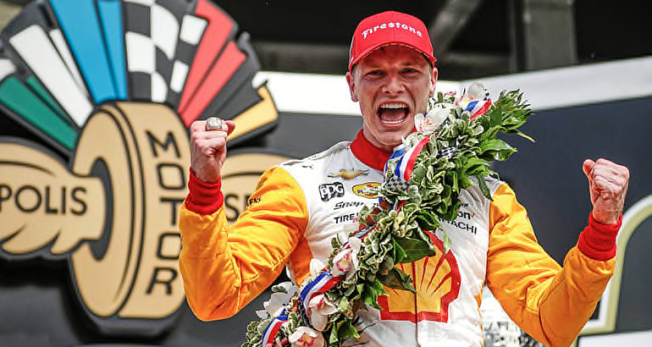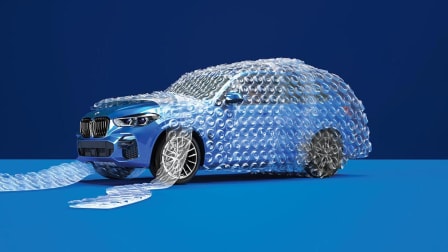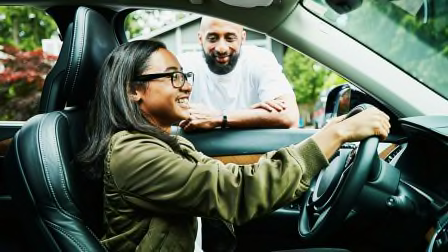9 Tips for Teen Drivers From 2023 Indy 500 Winner Josef Newgarden
Public roads can be as challenging as a race track, he says

IndyCar champ Josef Newgarden says that driving a car on the street has more in common with zipping around the ovals than you might think. To stay safe, he says, a racer and an everyday driver have to do the same things: make sure they’re properly positioned in the car, maintain focus and appropriate speed, and manage risks well.
As the winner of the 2023 Indianapolis 500 and a two-time NTT IndyCar Series champion (and the winningest current American driver in the series), Newgarden knows the challenges of racing firsthand. He also admits that he had an accelerated learning curve even before he got his driver’s license.
Tip #1: Set Yourself Up for Success
The correct driving position inside the race car is so important to Newgarden that his Penske team actually molds a seat to his body. But he’s no less picky about the setup in his daily driver.
“You need to make sure everything is set accordingly,” he says. Newgarden starts by adjusting the seat so his feet can reach the pedals easily and then he adjusts the steering wheel so it’s also within easy reach with his arms slightly bent. Then he dials in all his mirrors. And while his mechanics help him with the six-point racing harness in his Penske IndyCar, Newgarden never goes anywhere on the street without buckling his seat belt.
Find out how to set up a proper driving position.
Tip #2: Be a Mono-Tasker
“Your brain can only work on one thing at a time,” Newgarden explains. So he puts his phone away—and engages its Do Not Disturb mode—even before he gets in his car. He also knows that there are plenty of other potentially dangerous distractions lurking inside every road car: “You can’t be fiddling with the radio or settling someone down in the back seat when you’re trying to drive safely.”
Tip #3: Slow Down
Fans always ask Newgarden if he likes to drive fast on the road. His answer? No. “A race track is built for high-performance vehicles capable of high speeds,” he says. That means they have safety features like barriers and runoff areas you won’t find on public streets to slow down a car that leaves the road. “A road environment has a lot of obstacles,” he explains. “You’ve got telephone poles, trees, and ditches, even elevation changes.” And any of them can become dangerous for drivers going too fast.
Tip #4: Steer Clear of the Big Rigs
Newgarden tries to stay away from 18-wheelers whenever possible and advises young drivers to do the same. Why? Tractor-trailers generally have longer stopping distances than cars, giant blind spots, and massive tire treads that can go airborne. “I never want to be around them for very long,” says Newgarden. If you must pass a truck, always pass on the left, not the right, where their blind spots are biggest. And, like Newgarden, avoid driving alongside them.
Learn more about safely sharing the road with big rigs.
Tip #5: Look Ahead, Think Ahead . . .
Most drivers, young or old, focus only on the car immediately in front of them. One of the first things a race car driver learns is to look far ahead and Newgarden urges novice drivers to do the same on the road. “You should be looking 10 cars in front of you,” says Newgarden. If you’re looking that far ahead, you can see hazards in enough time to react. He also advises young drivers to plan their own moves well in advance. “You need to be thinking about changing lanes 30 seconds before you do it,” he says. It’s all part of his larger strategy of being a defensive driver. “You need to act like everyone on the road doesn’t know what they’re doing,” he laughs. “Because most people in America don’t.”
Tip #6: And Behind
It’s easy to think only about what’s going on in front, but Newgarden reminds drivers that they need to pay attention to what’s going on behind as well. Check your rear- and side-view mirrors constantly so you’re aware of what all the cars around you are doing and how close they are. That way you’ll know how hard you can or cannot brake if you need to. “You can’t just slam on your brakes if there’s a car right on your bumper,” he explains. “You might create a dangerous situation for the driver behind.”
Tip #7: Make Some Room
Wheel-to-wheel racing is the norm on the track, but on public roads, space is the final frontier. Newgarden advises young drivers to allow as much distance as possible from surrounding cars. “I like separation,” he explains. “You shouldn’t be clumped into a group of cars.” The reason is simple. Breathing room from nearby vehicles gives you extra time and more options when you encounter the unexpected. “Let’s say a wreck happens directly in front of you. You want to be able to avoid it by steering to the left or the right,” he says. “You always want to have an alternate plan, an exit strategy.” The National Safety Council recommends drivers stay at least three seconds behind any vehicle in front of them. To do this, begin counting one-thousand-one, one-thousand-two, one-thousand-three after the vehicle in front of you passes a stationary object on the side of the road. You should be no closer than three seconds (four in bad weather or other challenging conditions).
Tip #8: Compensate for the Weather
Newgarden has to control a race car with over 550 hp, so he knows all about traction. And since Indycars often race in the rain, he understands how much wet pavement changes the equation. “It reduces the grip potential by maybe 30 percent,” Newgarden says. He tells young drivers to begin by slowing down—which also diminishes the risk of the car hydroplaning, or winding up with water between the tire and the road.
In the rain, he looks even farther ahead than when he’s driving on dry pavement and gives other drivers more room than usual. "The condition of your tires is also extremely important,” says Ryan Pszczolkowski, who leads CR’s tire testing. “A worn tire or a tire with low tread depth is much more likely to hydroplane or skim across the surface of standing water. A deeper tread allows the water to escape and keeps your tires in contact with the road surface."

Photo: Phillip G. Abbott/LAT for Chevy Racing Photo: Phillip G. Abbott/LAT for Chevy Racing
Tip #9: Practice Makes Parking Perfect
“I’m pretty good,” says Newgarden of his parallel parking skills. “I can usually knock it out in one shot.” Younger drivers trying to ace the parking portion of a driver’s test need to put in the time to practice. He suggests that they start with good door-handle to door-handle alignment, and then turn the wheel as far as it will go in each direction as they’re backing into the spot. Once they’ve learned these basics, it’s all about practice. “Set up some cones, do 50 repetitions and you’ll get better,” he says.
It’s not just about the driver, says Jennifer Stockburger, director of operations at CR’s Auto Test Center.
“In addition to these important tips, the other key element to assure the safest driving experience for a new driver is to choose the right car,” Stockburger says. “Look for a reliable car that provides as much safety as a budget will allow, isn’t too big or too small, too fast or too slow, and has balanced handling.”
See CR’s picks for the best new and used cars for teens.




















